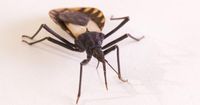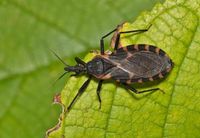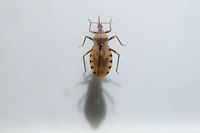Blood-sucking insects known as "kissing bugs" are making headlines across the United States, and not for good reason. On September 9, 2025, the U.S. Centers for Disease Control and Prevention (CDC) sounded the alarm with a new report: Chagas disease, a potentially fatal illness spread by these bugs, is now present in 32 states, raising concerns about its status as an emerging public health threat in the country.
Chagas disease, also called American trypanosomiasis, is caused by the parasite Trypanosoma cruzi. The primary culprits, triatomine insects—better known as kissing bugs—feed on the blood of animals and humans, often biting people near the mouth and eyes while they sleep. These insects earned their nickname from this unsettling habit. After feeding, the bugs defecate near the bite site, and the parasite enters the body when a person inadvertently rubs the contaminated feces into the wound, eyes, or mouth. According to the CDC, the disease is not spread by person-to-person contact but can be transmitted through blood transfusions, organ transplants, from mother to child during pregnancy, and, rarely, through contaminated food or laboratory accidents.
While Chagas disease has long been associated with rural regions of Central and South America, where it kills around 10,000 people each year, its presence in the United States is drawing new scrutiny. Experts estimate that up to 300,000 people in the U.S. may be infected—many without knowing it. "Labeling the United States as non–Chagas disease–endemic perpetuates low awareness and underreporting," the CDC report noted. The agency now proposes that Chagas disease in the U.S. be classified as endemic, or more specifically, hypoendemic, to reflect its established presence and spur greater vigilance.
The numbers are telling. Between 2013 and 2023, the Texas Department of State Health Services documented 50 probable and confirmed locally acquired cases—meaning the infections were not imported from abroad but contracted within Texas. Of these, three were identified in the acute phase, 44 during the chronic asymptomatic phase, and three in the chronic symptomatic stage. These individuals had no travel history to traditional Chagas-endemic areas, underscoring the risk of local transmission. Wildlife and domestic animals, especially dogs, frequently test positive for T. cruzi in Texas, raising the stakes for both animal and human health. Dogs, in particular, are at higher risk because they may eat the bugs, receiving a larger dose of the parasite than from a bite alone.
Chagas disease has now been reported in humans and wildlife across a swath of the U.S. Between 2000 and 2018, researchers identified 29 confirmed and 47 suspected locally acquired cases in eight states: Texas, California, Arizona, Tennessee, Louisiana, Missouri, Mississippi, and Arkansas. However, the true number of infections is likely much higher. Many cases go undiagnosed due to limited awareness and a lack of routine testing. The CDC stresses that "the burden of locally acquired human disease in the United States does not approach the levels seen in some regions of Latin America, but hope that labeling the United States as Chagas disease–endemic will also raise awareness for this neglected disease across its endemic range."
The disease itself can be insidious. Chagas progresses in two stages: acute and chronic. The acute phase, occurring in the weeks or months after infection, is often mild or even symptomless. When symptoms do appear, they can mimic the flu—fever, fatigue, body aches, headaches, and rashes are common. One telltale sign is swelling of one eyelid, known as Romaña’s sign, which occurs if the parasite enters through the eye. The acute phase lasts several weeks, and if caught early, treatment is highly effective. According to the CDC, "treatment is critical within a two-month acute phase."
Unfortunately, most people never realize they are infected. Between 60 and 70 percent of those with Chagas disease develop no symptoms at first. If untreated, the infection enters a chronic stage, where it can silently persist for years—even decades. About 20 to 30 percent of chronic cases eventually develop serious complications, often involving the heart. These can include heart rhythm abnormalities, an enlarged heart, heart failure, or sudden death. Digestive system problems, such as difficulty swallowing or severe constipation, may also arise. Without treatment, Chagas can be life-threatening, causing congestive heart failure and severe digestive issues.
Diagnosing Chagas is tricky. During the acute phase, a blood smear may reveal the parasite. In chronic cases, at least two different serologic tests are needed to detect antibodies, as no single test is completely reliable. The National Institutes of Health recommends that anyone who suspects a kissing bug bite—especially in areas where the insects are found—should consult a healthcare practitioner. Early detection is crucial, as "treatment effectiveness decreases significantly over time." The two main medications, benznidazole and nifurtimox, are most effective when given soon after infection, with cure rates exceeding 90 percent in the first year.
So, what can be done to prevent this disease from spreading further? The CDC and other experts recommend a combination of public awareness, practical prevention, and targeted screening. Individuals living in or traveling to areas where kissing bugs are present should take precautions: use insect repellent, seal cracks and crevices in walls and roofs, install screens on windows and doors, and sleep under insecticide-treated bed nets when camping or staying in rustic accommodations. Avoid sleeping outdoors or in poorly constructed housing where bugs may hide. If you spot a kissing bug, don’t crush it with your bare hands—capture it safely and contact local health authorities.
Screening is especially important for people with a history of living in or traveling to endemic areas, pregnant women from these regions, and those donating blood or organs. Since 2006, blood and organ donors in the U.S. have been screened for Chagas disease to help prevent transmission through medical procedures. Pregnant women who test positive can still usually breastfeed, unless there is visible blood or cracked nipples, to avoid mother-to-child transmission.
As for Canada, experts say the risk remains low. The climate there isn’t suitable for kissing bugs to establish themselves, and Chagas cases in Canadians are typically linked to travel abroad. Still, the northward shift of disease vectors due to global warming is a growing concern among scientists, who warn that the borders for endemic infections are shifting.
The CDC’s latest call to action is clear: more testing, more awareness, and more preventive measures are needed as Chagas disease cements its place as an endemic threat in the United States. With increased vigilance and early intervention, the worst outcomes of this once-neglected tropical disease can be avoided, safeguarding both public health and peace of mind for communities across the country.


